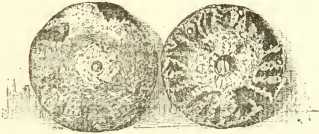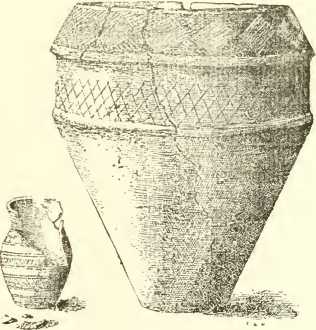|
The most remarkable piece
of antiquity in the parish besides the old Bridge of Dee is a “Druidical Temple,” situated on an eminence about a mile and a half from
the coast, which was still within these few years remarkably perfect. It
consisted of three circles of stone within each other. The outer circle,
which was about forty-five feet in diameter, consisted of twelve large
stones placed on end. The inner circles were composed of smaller ones
placed in the same manner, and between the two outermost, upon the east
side, there was a stone chest, sunk in the earth, about three feet long
and one-and-a-half wide, which having been accidentally uncovered by a
countryman, disclosed an urn in which nothing but a little dust or ashes
was found. A little farther down the hill towards the south-east there
is another erection of the same kind. It consists of one circle of
pretty large stones.

An exploring party
consisting of Mr. Dyce Nicol of Ballogie, Mr. C. S. Dalrymple of
Westhall, Mr. Nicolson of Glenbervie, Captain Burnett, yr. of Monboddo,
the Rev. Mr. Stewart of Oathlaw, and Mr. Thomson of Banchory, carefully
inspected these circles, and the latter specially reported on them to
the Society of Antiquaries of Scotland. The conclusion arrived at was,
that one use of them was as a place of burial, but whether the persons
buried had been sacrificed on the spot as victims of a cruel
superstition, or were heroes in whose honour the stones had been set up,
they could not determine. They found no trace of sculpture, or
inscriptions, nor of flint knives or weapons..A gentleman writing in
beginning of the present century, observes that a workman having cut one
of these druidical stones, which had fallen from its upright situation,
produced out of it a millstone and forty feet of pavement. Close to the
principal circle there are two fields of extraordinary fertility,
although much encumbered with large quantities of stone interspersed
through them.
The soil of these fields
has been long remarked for its productiveness; and the tradition of the
country is, that in the time of the Picts, soil had been brought to
these fields, all the way from Findon, a distance of two miles, and that
this was done by ranging a line of men along the whole distance, who
handed the earth from the one to the other,
Near Cults House were
three stone cairns, all of remarkable size, where it is stated that at
an early age a battle was fought between the Scots and Picts. Whether
these had been intended to mark the scene of the battle or the resting
place of certain warrior chiefs who had fallen in the fray, remains a
mystery. Latterly two of the cairns have been greatly diminished in
size, and the third has been entirely removed by the withdrawal of the
stones for building purposes. In the removed cairn were discovered arrow
heads, and a sword, but the latter was of quite modern manufacture.
Nearly four hundred years
ago an important find was made near Findon, which consisted, as quaintly
described by Bellenden, “of ane ancient sepulture in quhilk wer ii lame
piggis craftely maid with letteris ingrauit, full of brynt powder,
quhilkis sone efter that they wer handillit fel in dros.”
A few stone coffins have
been found in various parts of the parish at different times. In August,
1817, one was discovered in repairing a road on the farm of Clasfarquhar,
at a spot about a quarter of a mile from the sea, and on the top of a
bank of gravel. “The coffin was composed of eight stones, two at each
side, one at each end and two forming the cover; and contained the
remains of a human skeleton, and two vases or urns. The skeleton,
although considerably decayed, appeared from the jaws to be that of an
adult. The larger of the vases, which was accidentally broken by the
labourers, must have been about ten inches in diameter, and five in
height. The smaller was six-and-a-half inches high, and five across the
mouth. They appear to have been made of pounded granite and mica slate,
commonly found in the vicinity, and covered with a coating of clay,
ornamented with small patterns executed with considerable care. The
vases were round as if turned in a lathe, and appeared to have been
dried in the sun. At what period this deposit was made must be purely
matter of conjecture.” Two other stone coffins were found in 1850, a
little to the north of Cults mansion-house. They contained skulls,
bones, and other remembrances of mortality. A curious feature of this
find was a row or circle of stones enclosing an area of almost eighteen
feet in diameter. Another stone coffin was found in forming that part of
the turnpike road which passes through the estate of Ardoe. No tool
appeared to have been employed to carve it out. It was bedded in the
shingle (not sand) was only two-and-a-half feet long by two broad, and
contained an urn, within which was a human skull of a small size, but
apparently that of an adult.
Stone cists were
discovered on the estate of Banchory in 1823, and again in 1847. Two of
these were in a gravel hillock, and each contained an urn of baked clay,
in addition to which there was a gold ring in one of them. Unfortunately
one of the urns got broken, but the other, which was shaped somewhat
like the head of a thistle and richly ornamented, has been carefully
preserved.
Among the varied objects
in the collection of the Society of Antiquaries of Scotland is a skull
found in an ancient cist on Clashfarquhar in 1822. “ It is that of a
young man, of small size, imperfect, and extremely fragile, owing to the
loss of most of its animal matter. On the crown of the head is a hole,
nearly circular, and rather more than an inch in diameter, caused, it
may be presumed, by the blow of a stone axe, which had abruptly
terminated the earthly career of its owner. In form and cerebral
development it corresponds to a class of skulls found in the earliest
Scottish cairns and barrows; and, as already said, it is not difficult
to conceive of the wound having been inflicted by the narrow end of a
stone celt. In each corner of the cist, from which the skull was taken,
lay a few flint flakes carefully piled up into a heap, the sole evidence
of the rude arts of the period to which it pertained. Mr. Thomson of
Banchory remarked of them, in a letter which accompanied the donation of
the skull:— ‘They are very proper for being made into arrow heads, but
none of them appear to have been wrought’.”
About sixteen years ago,
owing to the flooding of the river Dee, a landslip took place on the
south Deeside turnpike road, at a point due north of the Mansion House
of Ardoe. A large quantity of material being required to fill up the gap
which had been made, Mr. Ogston gave permission to the Road Trustees to
remove a gravel knoll in a field east of his stables. During the
progress of the operations, the workmen came upon several ancient
graves, in which at least one complete skeleton, bones, three urns, and
part of an old lamp were found. The skeleton was presented to the Museum
of Marischal College, and one of the urns to the late Dr. John Stuart,
whilst the two remaining ones are preserved in the house of Ardoe.

Unis found at Ardoe.
Of these two, the larger
one measures fully two feet in height, whilst the smaller one, which
unfortunately got somewhat broken by the workmen, is
eight-and-three-fourth inches high. The latter is richly ornamented, and
seems to be of a quality and shape entirely different from the larger
one. At what time the interments had taken place it is difficult to
estimate, although antiquaries generally believe it was shortly after
the Romans had left the country.
Within recent years an
axe head, and flints of two distinct colours, have been unearthed, close
to a running stream in the grounds of Lynwood, Deebank, belonging to Mr.
George D. Rutherford.

Axe Head found at Lynwood.
The axe head measures
eight-and-a-half inches in length, by about three inches in breadth, and
weighs close on two pounds. It is believed that the natives had an
encampment at Deebank during the stone age.
About twenty years ago a
splendid specimen of the ancient quern, or hand-mill, was dug out of a
piece of mossy ground in the hollow below West Cults. It belonged to the
late Mr. Alexander Hepburn, Birchfield, and is now in the custody of the
author, with a view to being handed over to the
Public Museum in Aberdeen when such is instituted. The lower stone
measures eighteen-and-a-half inches in diameter, by about three inches
in thickness, and the upper one is slightly less. Each has a hole bored
through the centre to admit of being fastened to the ground, the upper
one, of course, having an opening sufficiently large to allow of its
being easily turned round, and the corn at the sametime allowed to run
in. It has, in addition, a small hole near the upper edge for holding a
handle with which to drive it. The smooth surfaces are cut with a
downward inclination towards the outside, so as to let the flour or meal
run out more easily.

Quern found below West
Cults. |

